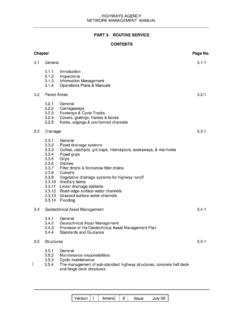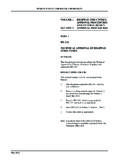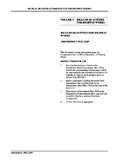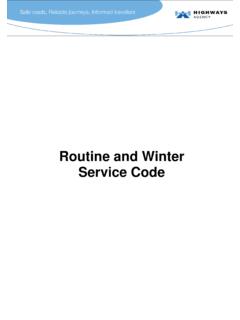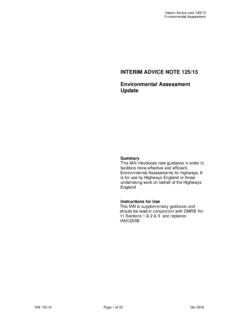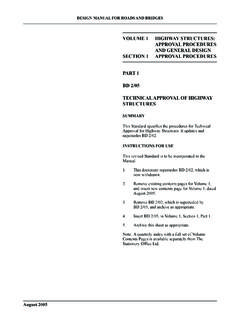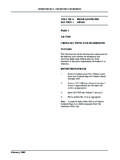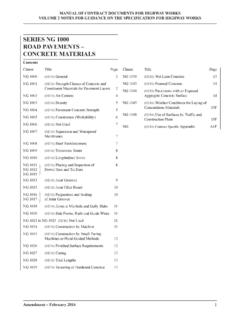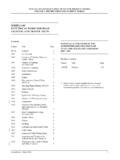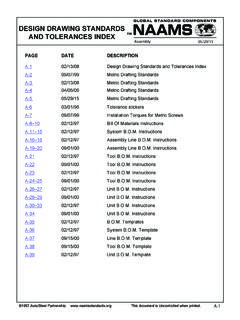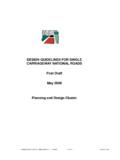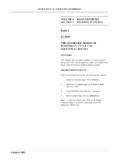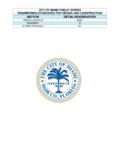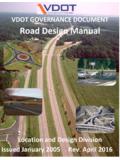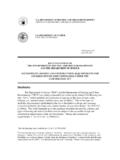Transcription of TD 16/07 - Standards for Highways
1 August 2007 design MANUAL FOR ROADS AND BRIDGESVOLUME 6 ROAD GEOMETRYSECTION 2 JUNCTIONSPART 3TD 16/07 geometric design OFROUNDABOUTSSUMMARYThis document sets out the design Standards and advicefor the geometric design of roundabouts. It supersedesTD 16 FOR contents pages from Volume 6 and insertnew contents pages dated August TD 16/93 from Volume 6, Section new Advice Note TD 16/07 into Volume 6,Section archive this sheet as : A quarterly index with a full set of VolumeContents Pages is available separately from TheStationery Office 16/07 Volume 6, Section 2,Part 3 geometric design ofRoundaboutsDESIGN MANUAL FOR ROADS AND BRIDGESTHE Highways AGENCYTRANSPORT SCOTLANDWELSH ASSEMBLY GOVERNMENTLLYWODRAETH CYNULLIAD CYMRUTHE DEPARTMENT FOR REGIONAL DEVELOPMENTNORTHERN IRELANDS ummary:This document sets out the design Standards and advice for the geometricdesign of roundabouts.
2 It supersedes TD 16 6 Section 2 Part 3 TD 16/07 August 2007 REGISTRATION OF AMENDMENTSA mendPage NoSignature & Date ofAmendPage NoSignature & Date ofNoincorporation ofNoincorporation ofamendmentsamendmentsRegistration of AmendmentsVolume 6 Section 2 Part 3 TD 16/07 August 2007 REGISTRATION OF AMENDMENTSA mendPage NoSignature & Date ofAmendPage NoSignature & Date ofNoincorporation ofNoincorporation ofamendmentsamendmentsRegistration of AmendmentsVOLUME 6 ROAD GEOMETRYSECTION 2 JUNCTIONSPART 3TD 16/07 geometric design at of of Users Specific Aspects of MANUAL FOR ROADS AND BRIDGESA ugust 2007 Volume 6 Section 2 Part 3 TD 16/07 August 20071/1 Chapter 1 Introduction1. a major review of the geometricdesign of roundabouts (see TRL Published ProjectReport PPR206 International comparison ofroundabout design guidelines ) and extensiveconsultation, this document provides details of thelatest requirements and recommendations on designprinciples for safe and efficient document supersedes Standard TD 16/93(DMRB ).
3 Are junctions with a one-waycirculatory carriageway around a central on the circulatory carriageway have priorityover those approaching the roundabout . This documentdescribes the geometric design of the various types ofroundabout for application to new and improvedjunctions on trunk main types of roundabout are Mini,Compact, Normal, Grade Separated, Signalised andDouble Roundabouts (the last being a combination ofMini, Compact or Normal Roundabouts) and aredescribed in Chapter standard applies to Compact, Normal andGrade Separated Roundabouts. Mini-roundabouts arecovered by TD 54 (DMRB ) and SignalisedRoundabouts by TD 50 (DMRB ). In thisdocument, the term roundabout therefore excludesmini-roundabouts and signalised roundabouts unlessotherwise are given on the selection ofroundabout type, geometric layout, visibilityrequirements and crossfall, with respect to the speedlimit on the approach roads, the traffic flow and thelevel of non-motorised user significant change from TD 16/93 is the newCompact roundabout which has single-lane entries andexits, so that only one vehicle can enter or leave it froma given arm at any one time (see Chapter 3).
4 Changes are as follows:a)greater emphasis on non-motorised users (seeChapter 5);b) design hierarchy (see Chapter 6);c)when assessing entry deflection on a roundaboutarm, the entry path radius must be checked for allturning movements (see paragraphs );d)outward sloping crossfall, such that drainage isaway from the centre of the roundabout , may beused at smaller Normal and CompactRoundabouts in urban areas (see paragraph );e)except at Compact Roundabouts in urban areas,the projection of the kerb line of the splitterisland or central reserve on the approach shouldguide drivers around the central island (seeparagraph );f)advice is given on limiting visibility to the righton the approach to some roundabout types (seeparagraph );g)on larger roundabouts, the use of additional signsand markings is recommended (see ).Mandatory sections of this document arecontained in boxes.
5 The design Organisation mustcomply with these sections or obtain agreement toa Departure from Standard from the OverseeingOrganisation. The remainder of the documentcontains advice and explanation, which iscommended to users for This standard must be used forthwith for thedesign of all schemes for the construction andimprovement of trunk roads including motorwayscurrently being prepared, provided that in theopinion of the Overseeing Organisation, this wouldnot result in any significant additional expense orVolume 6 Section 2 Part 3 TD 16/07 August 20071/2 Chapter 1 Introductiondelay. The design Organisation must confirm itsapplication to particular schemes with theOverseeing from In exceptional situations, the OverseeingOrganisation may be prepared to agree to aDeparture from Standard where the Standard,including permitted Relaxations, is not realisticallyachievable.
6 design Organisations faced by suchsituations and wishing to consider pursuing thiscourse must discuss any such option at an earlystage in design with the Overseeing to adopt Departures from Standard mustbe submitted by the design Organisation to theOverseeing Organisation and formal approvalreceived before incorporation into a design In difficult circumstances, Relaxations maybe introduced at the discretion of the DesignOrganisation, having regard to all relevant localfactors, but only where specifically permitted bythis Standard. Careful consideration must be givento layout options incorporating Relaxations, havingweighed the benefits and any potential attention must be given to the safetyaspects (including operation, maintenance,construction and demolition) and theenvironmental and monetary benefits/disbenefitsthat would result from the use of Relaxations.
7 Theconsideration process must be recorded. Thepreferred option must be compared against optionsthat would meet full The principal objective of roundabout design isto minimise delay for vehicles whilst maintaining thesafe passage of all road users through the junction. Thisis achieved by a combination of geometric layoutfeatures that, ideally, are matched to the flows in thetraffic streams, their speed, and to any localtopographical or other constraints such as landavailability that apply. Location constraints are oftenthe dominating factor when designing improvements toan existing junction, particularly in urban Roundabouts should be designed to matchforecast demand. They work most efficiently whenvehicular flows are reasonably balanced between thearms, but they may also be the optimum choice in othercases, having taken into account the OverseeingOrganisation s assessment criteria.
8 However, they maynot be appropriate for use with Urban Traffic Control(UTC) or Integrated Demand Management (IDM)systems, or for other circumstances where accesscontrol is Entry width and sharpness of flare are the mostimportant determinants of capacity, whereas entrydeflection is the most important factor for safety as itgoverns the speed of vehicles through the effect of these variables can be predicted using themodels given in TRL Reports LR942 and LR1120 andincorporated into suitable The associated traffic signs and road markingscan significantly affect the safety and the capacity of aroundabout. Consequently, designers should considerthe need for and layout of traffic signs and roadmarkings as an integral part of the design process (seeparagraphs to ). The Traffic SignsRegulations and General Directions (TSRGD)prescribe the designs and conditions of use for trafficsigns and road markings.
9 Guidance on the applicationof TSRGD can be found in the Traffic Signs on signing is also given in Local TransportNote LTN 1/94). The legislation referred to in this document may,in some instances, have a specific Northern Irelandequivalent. For schemes in Northern Ireland, thedesigner should refer to the Overseeing Organisationfor roundabout design must allow formaintenance issues and activities, includinglandscaping and the need for inspection andservice of road studs and markings. Anyimplications for activities such as road sweeping,general routine maintenance, resurfacing andwinter maintenance operations, and the possibleneed for a maintenance hard standing must 6 Section 2 Part 3 TD 16/07 August 20072/1 Chapter 2 Safety at Roundabouts2. SAFETY AT 2004 there were about 207,400 personal injuryroad accidents in Great Britain (Road CasualtiesGreat Britain, 2004).
10 Of these, about 18,000 ( )occurred at roundabouts. The proportion of accidents atroundabouts which were fatal was , of all other junction accidents and of linkaccidents were fatal. This indicates the effectiveness ofroundabouts in reducing accident severity. The averageaccident cost at a roundabout was calculated to be about68% of that at other junction types and about 47% ofthat on links. This suggests that on average,roundabouts are safer than other junction , this will not necessarily be the case for allroad users or for a particular study undertaken in 2004 (TRL UnpublishedReport UPR/SE/194/05) determined the accidentfrequencies (accidents per year) by severity over a fiveyear period (see Table 2/1) for a sample of 1,162roundabouts. The sample comprised all roundabouts insome local authorities, but only the busier roundaboutsin others, making the analysis slightly biased towardsbusier roundabouts.
